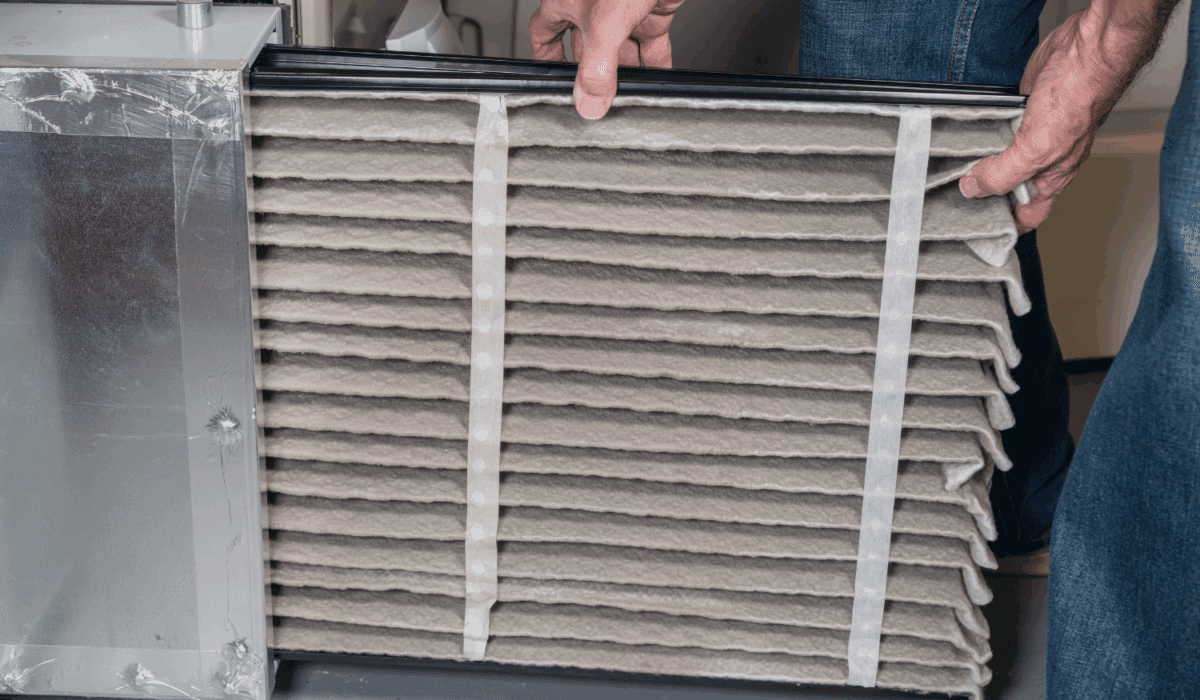If you have ever wondered how often to change a furnace filter, you are already ahead of many homeowners. The furnace filter is one of the most overlooked yet vital parts of your HVAC system. It keeps dust, debris, and allergens out of your air and protects your furnace from unnecessary strain.
The problem is that many people do not realize how much a dirty filter affects performance. When your furnace filter clogs, the system works harder, your energy bills rise, and your home’s air quality drops. This simple part, when maintained properly, can extend the life of your heating and cooling system, improve efficiency, and create a cleaner indoor environment.
In this article, Edifice Inspections explains exactly how often Georgia homeowners should change a furnace filter, what affects their replacement schedule, and how to keep their system running at its best.
Why Furnace Filter Changes Matter
Changing your furnace filter regularly might sound minor, but it makes a big difference in how well your home’s heating and cooling system performs. The filter’s main job is to catch dust, dirt, lint, pet dander, and even small airborne particles before they reach your furnace’s motor and coils.
Without it, those contaminants can build up inside your HVAC system and circulate back into your home.
When air cannot pass through easily, your furnace has to work harder to pull air through the ducts. That added strain shortens the life of your blower motor and can lead to breakdowns that are expensive to repair.
It also reduces airflow, meaning it takes longer to heat or cool your home.
There is also an important health factor. A dirty filter lets allergens and dust flow freely through your home, triggering allergies and asthma symptoms. For families with children, elderly members, or anyone sensitive to air quality, this can make a big difference.
Basic Guidelines for Most Homes
So, how often should you really change your furnace filter? The short answer: every 1 to 3 months for most homes.
This general rule works for standard filters used in most household HVAC systems. However, the exact frequency depends on your home’s specific conditions. Thin filters clog faster and need replacing sooner, while thicker, higher-quality filters last longer.
Here are some common examples:
- Fiberglass filters (1-inch): Replace every 30 days. These are affordable but trap less dust and fill quickly.
- Pleated filters (1–2 inch, MERV 8–11): Replace every 60 to 90 days. These are the most common household filters and balance cost with good air filtration.
- High-efficiency filters (4–5 inch, MERV 11+): Replace every 6 to 12 months. These thicker filters last longer and capture smaller particles, but not all systems can handle them.
- If you are unsure of your filter type, check it once a month. If it looks dusty or gray, change it right away.

Key Factors That Affect Your Schedule
Every home is unique, and several factors influence how often to change the furnace filter. Here is what you should consider when setting your replacement schedule:
1. Pets
Homes with cats or dogs accumulate more pet hair and dander. Even with good vacuuming habits, these tiny particles reach the air ducts and stick to the filter. If you have pets, check your filter every month and plan to replace it every 30 to 45 days.
2. Allergies or asthma
If someone in your household struggles with allergies or asthma, cleaner air makes a huge difference. Use a filter with a higher MERV rating and replace it more frequently to trap pollen, mold spores, and dust mites.
3. Air quality and environment
Your home’s location also matters. If you live near a construction zone, a dirt road, or a smoky area, airborne particles will clog the filter faster. In these situations, monthly checks are best.
4. Season and system usage
Your filter will get dirtier during seasons when your system runs more often. In winter and summer, when your HVAC operates daily, change your filter more frequently.
5. Filter size and quality
Thicker filters can hold more debris before they restrict airflow. However, they also cost more. Always check that your system supports the filter thickness before upgrading.
6. Number of occupants
More people in the home means more activity and more airborne particles. A household of five will likely need more frequent replacements than a single-person home.
The more dust, activity, or air movement your home has, the more often your furnace filter should be replaced.
Signs Your Filter Needs Changing Now
You do not always have to count the days to know when your filter needs replacing. Your home will often give you clear signs. Here is what to look for:
- The filter surface looks gray, dusty, or fuzzy.
- Air feels weak or uneven coming through vents.
- You notice more dust collecting on furniture or surfaces.
- The furnace runs longer to heat or cool your home.
- There is a musty smell when the system turns on.
- Your energy bill suddenly increases without any change.
Try holding the filter up to a light. If you can barely see light passing through, it is time for a new one. If your furnace sounds louder, runs longer, or the air feels weaker, change your filter immediately.
How to Choose and Install the Right Filter
Choosing the correct filter keeps your system healthy and ensures you are not wasting money on the wrong type.
Choosing the right filter:
- Match the size. Look at the old filter’s dimensions, usually printed on the frame. Common sizes are 16x25x1 or 20x20x1 inches.
- Check the MERV rating. The MERV scale runs from 1 to 16 and measures how well the filter traps particles. For most homes, a rating between 8 and 11 is ideal. Higher ratings capture finer particles but may restrict airflow if your furnace is not designed for them.
- Consider your lifestyle. Homes with pets, children, or people with allergies benefit from higher MERV filters.
Installing the new filter:
- Turn off your furnace or HVAC system.
- Open the filter compartment, usually at the air return or blower compartment.
- Slide the old filter out carefully and dispose of it.
- Insert the new filter with the airflow arrow pointing toward the furnace.
- Close the access panel and restart the system.
- Mark the replacement date somewhere visible, like on the filter edge.
Always use the correct filter size and rating for your system, and double-check the airflow direction before installing.

How to Remember When to Change Your Furnace Filter
With busy schedules, it is easy to forget about furnace filter changes. The good news is that there are simple ways to make it automatic.
- Set digital reminders. Add a repeating event to your phone calendar every 30, 60, or 90 days.
- Label your filter. Write the date of installation on the filter frame so you know at a glance how old it is.
- Use smart home tech. Smart thermostats can alert you when it is time to change your filter based on usage.
- Try a subscription service. Many online stores deliver new filters automatically at your chosen interval.
Keeping up with this one small task saves time, money, and effort in the long run.
Seasonal Furnace Filter Maintenance Tips
Your furnace filter needs attention all year. Follow this seasonal guide to stay consistent:
| Season | Maintenance Tip |
| Winter | Check and replace filters every 30 days during heavy heating use. |
| Spring | Change your filter before allergy season to trap pollen and dust. |
| Summer | If using central air, inspect your filter monthly and replace as needed. |
| Fall | Replace before the heating season starts for better efficiency. |
Pairing your filter changes with other seasonal tasks like gutter cleaning or HVAC tune-ups keeps your home maintenance simple and organized.
High humidity in Georgia can make your furnace work harder to maintain comfort and cause your air filter to clog faster with moisture, dust, and mold buildup.
In fact, Georgia’s average relative humidity is 71% with a dew point of 53 degrees Fahrenheit.
During the summer, replacing your filter monthly helps your HVAC system handle the heavier cooling load efficiently and keeps indoor air cleaner despite the extra pollen and humidity.
Use the seasons as your reminder points to ensure your system stays clean and efficient year-round.
What Happens If You Skip or Delay the Change?
Ignoring your furnace filter may not seem like a big deal, but over time, it can cause serious problems.
- Reduced airflow: Your system works harder, making it less efficient.
- Higher energy bills: The harder your furnace runs, the more electricity or gas it uses.
- Uneven heating and cooling: Dirty filters restrict airflow, causing temperature imbalances.
- Shortened equipment lifespan: Dust buildup stresses components like the blower motor and heat exchanger.
- Poor air quality: Dust, allergens, and even mold can spread through the home.
- Possible system damage: In extreme cases, the furnace may overheat or shut down entirely.
Next Steps
At Edifice Inspections, we often see the results of neglected furnace filters during home inspections. Dirty filters are a leading cause of premature HVAC failure and poor indoor air quality.
We recommend making filter care part of your seasonal home maintenance checklist.
If you are unsure how to choose the right filter or suspect other airflow issues, schedule a professional inspection. Our team will review your furnace, air ducts, and system components to ensure everything is running safely and efficiently.
Related Questions
Can I clean and reuse my furnace filter?
Only washable filters can be cleaned and reused. Most disposable filters should be replaced completely.
Do high-efficiency filters last longer?
Yes. Thick filters with higher MERV ratings can last up to 12 months, but you should still inspect them monthly.
How often should I change the furnace filter if I have pets or allergies?
Every 30 to 45 days is best to maintain clean, healthy air.
What’s the easiest way to track filter changes?
Use an organizer, like your phone’s reminder app, write the date on the filter, or sign up for a delivery service.
When to Call a Professional
If your furnace runs constantly, produces odd noises, or your air feels dusty even after replacing the filter, it is time to call a professional.
A certified HVAC technician or home inspector can check for blocked ducts, blower issues, or ventilation problems. During a home inspection, Edifice Inspections evaluates your HVAC system for performance, safety, and overall efficiency.
Conclusion
Knowing how often to change the furnace filter helps protect your Georgia home, your comfort, and your wallet. It is one of the simplest ways to keep your system healthy and your air clean.
Make a habit of checking your filter monthly, replacing it as needed, and setting reminders to stay consistent. Regular attention prevents costly repairs and keeps your indoor air fresh all year.
When you are ready for a full home or HVAC inspection, contact Edifice Inspections. Our experienced inspectors will ensure your system is operating efficiently, safely, and ready for every season.

